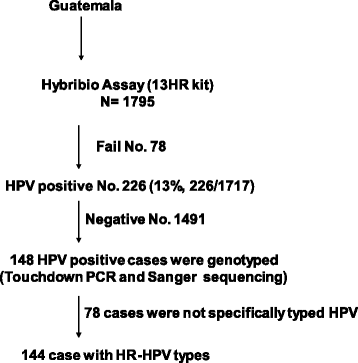Low-cost HPV testing and the prevalence of cervical infection in asymptomatic populations in Guatemala
- PMID: 29764400
- PMCID: PMC5952444
- DOI: 10.1186/s12885-018-4438-y
Low-cost HPV testing and the prevalence of cervical infection in asymptomatic populations in Guatemala
Erratum in
-
Correction to: Low-cost HPV testing and the prevalence of cervical infection in asymptomatic populations in Guatemala.BMC Cancer. 2020 Feb 28;20(1):164. doi: 10.1186/s12885-020-6672-3. BMC Cancer. 2020. PMID: 32111179 Free PMC article.
Abstract
Background: A low cost and accurate method for detecting high-risk (HR) human papillomavirus (HPV) is important to permit HPV testing for cervical cancer prevention. We used a commercially available HPV method (H13, Hybribio) which was documented to function accurately in a reduced volume of cervical specimen to determine the most prevalent HPV types and the distribution of HPV infections in over 1795 cancer-free women in Guatemala undergoing primary screening for cervical cancer by cytology.
Methods: HR-HPV detection was attempted in cervical samples from 1795 cancer-free women receiving Pap smears using the Hybribio™ real-time PCR assay of 13 HR types. The test includes a globin gene internal control. HPV positive samples were sequenced to determine viral type. Age-specific prevalence of HPV was also assessed in the study population.
Results: A total of 13% (226/1717) of women tested HPV+, with 78 samples (4.3%) failing to amplify the internal control. The highest prevalence was found in younger women (< 30 years, 22%) and older ones (≥60 years, 15%). The six most common HR-HPV types among the 148 HPV+ typed were HPV16 (22%), HPV18 (11%), HPV39 (11%), HPV58 (10%), HPV52 (8%), and HPV45 (8%).
Conclusions: In this sample of cancer free women in Guatemala, HPV16 was the most prevalent HR type in Guatemala and the age-specific prevalence curve peaked in younger ages. Women in the 30-59-year age groups had a prevalence of HR-HPV of 8%, however, larger studies to better describe the epidemiology of HPV in Guatemala are needed.
Keywords: Cervical cancer; Guatemala; HPV; Prevalence; Real-time PCR; Screening.
Conflict of interest statement
Ethics approval and consent to participate
This study was approved by the ethics committee of the Hospital General San Juan de Dios, and the Instituto de Cancerologia, Guatemala and testing in the US laboratory was judged exempt by the NIH Office of Human Studies Research. All subjects signed an approved informed consent form.
Competing interests
The authors declare that they have no competing interests.
Publisher’s Note
Springer Nature remains neutral with regard to jurisdictional claims in published maps and institutional affiliations.
Figures


Similar articles
-
Cervical high-risk human papillomavirus infection among women residing in the Gulf Cooperation Council countries: Prevalence, type-specific distribution, and correlation with cervical cytology.Cancer Cytopathol. 2019 Sep;127(9):567-577. doi: 10.1002/cncy.22165. Epub 2019 Aug 7. Cancer Cytopathol. 2019. PMID: 31390155
-
HPV genotype distribution and cervical lesions in Chongqing: a comprehensive analysis of 229,770 females (2015‒2023).BMC Infect Dis. 2025 May 27;25(1):760. doi: 10.1186/s12879-025-11128-6. BMC Infect Dis. 2025. PMID: 40426145 Free PMC article.
-
High-risk human papillomavirus genotype distribution and attribution to cervical cancer and precancerous lesions in a rural Chinese population.J Gynecol Oncol. 2017 Jul;28(4):e30. doi: 10.3802/jgo.2017.28.e30. J Gynecol Oncol. 2017. PMID: 28541628 Free PMC article.
-
Global prevalence of cervical human papillomavirus in women aged 50 years and older with normal cytology: a systematic review and meta-analysis.Lancet Microbe. 2025 Jan;6(1):100955. doi: 10.1016/j.lanmic.2024.100955. Epub 2024 Nov 29. Lancet Microbe. 2025. PMID: 39622259
-
The human Papillomavirus twilight zone - Latency, immune control and subclinical infection.Tumour Virus Res. 2023 Dec;16:200268. doi: 10.1016/j.tvr.2023.200268. Epub 2023 Jun 23. Tumour Virus Res. 2023. PMID: 37354969 Free PMC article. Review.
Cited by
-
Correction to: Low-cost HPV testing and the prevalence of cervical infection in asymptomatic populations in Guatemala.BMC Cancer. 2020 Feb 28;20(1):164. doi: 10.1186/s12885-020-6672-3. BMC Cancer. 2020. PMID: 32111179 Free PMC article.
-
Development of a Cervical Cancer Screening Program in Rural Guatemala.Glob Health Sci Pract. 2025 Aug 14;13(1):e2400282. doi: 10.9745/GHSP-D-24-00282. Print 2025 Aug 14. Glob Health Sci Pract. 2025. PMID: 40813245 Free PMC article.
-
Barriers to Cervical Cancer Screening and the Cervical Cancer Care Continuum in Rural Guatemala: A Mixed-Method Analysis.J Glob Oncol. 2018 Jul;4:1-10. doi: 10.1200/JGO.17.00228. J Glob Oncol. 2018. PMID: 30084698 Free PMC article.
-
HPV Prevalence and Genotype Distribution Among Women From Hengyang District of Hunan Province, China.Front Public Health. 2021 Nov 5;9:710209. doi: 10.3389/fpubh.2021.710209. eCollection 2021. Front Public Health. 2021. PMID: 34805062 Free PMC article.
-
High-risk HPV prevalence and genotype distribution among women in Liaocheng, Shandong Province, China from 2016 to 2022.Front Public Health. 2023 Mar 30;11:1145396. doi: 10.3389/fpubh.2023.1145396. eCollection 2023. Front Public Health. 2023. PMID: 37064671 Free PMC article.
References
MeSH terms
Grants and funding
LinkOut - more resources
Full Text Sources
Other Literature Sources
Medical
Research Materials
Miscellaneous

